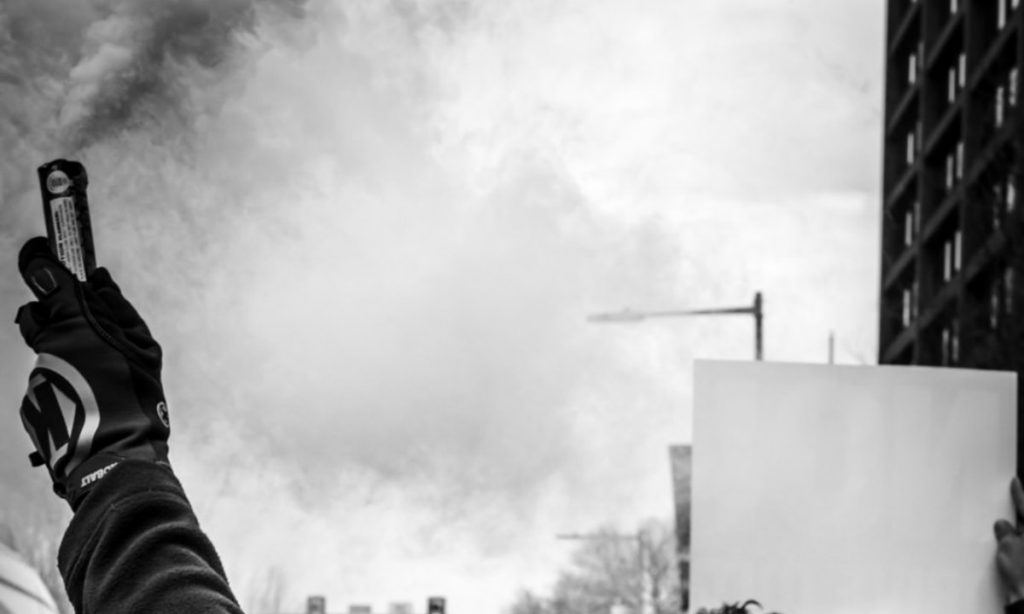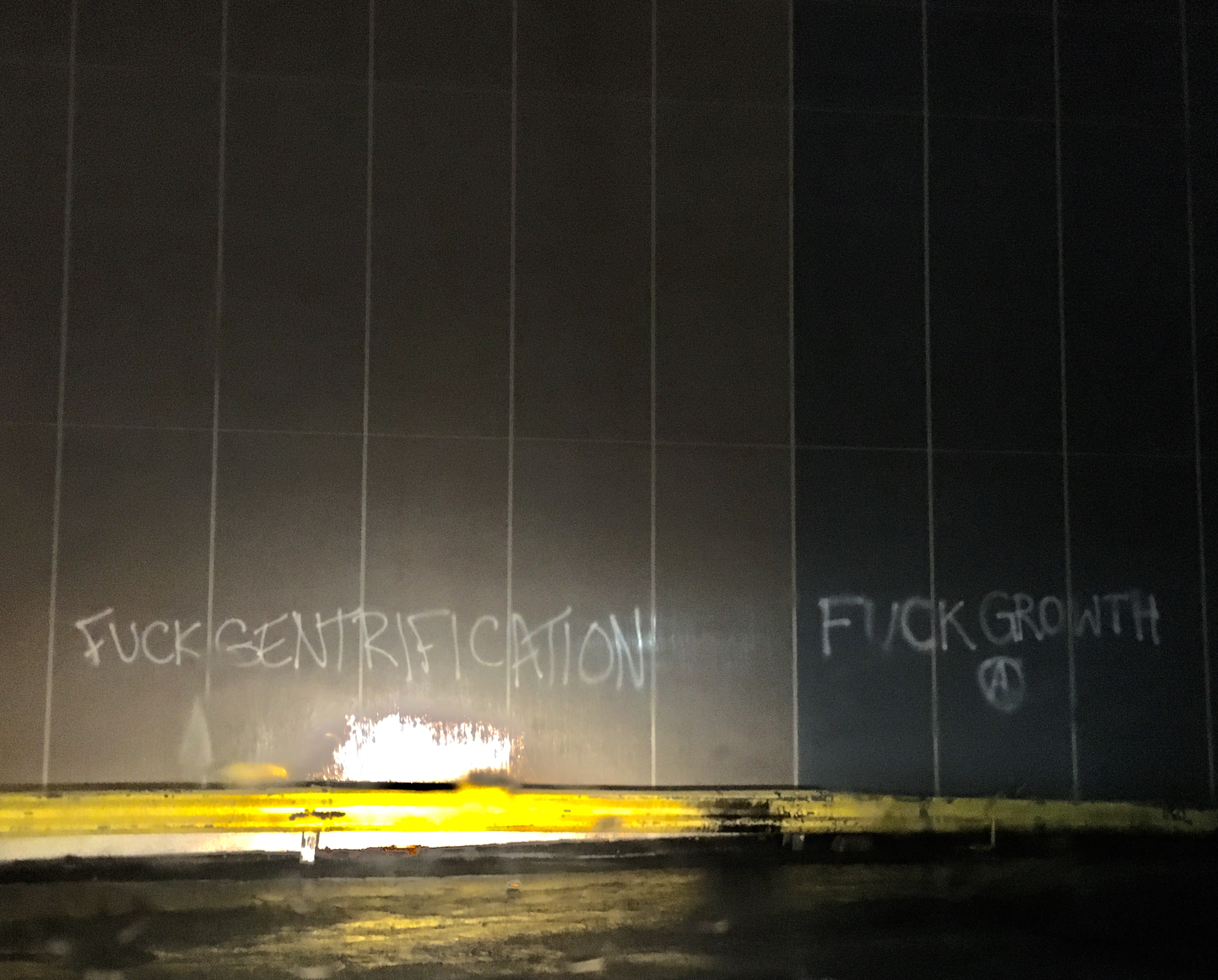from Anathema

The following piece offers some thoughts on anarchist activity in Philly in 2017. Like any reflection worth its salt, this one is meant to inspire thought, conversation, and ultimately action.
Changes
The most noticeable change in the anarchist space has been its increase in size, alongside a deepening and broadening of anarchist activity in Philly. An ever-changing place, the anarchist space has seen an influx of new people and ideas. More punks, more overlapping with the left, and definitely more anti-fascism. Many of the struggles anarchists engaged in prior to 2017 have escalated, and anarchists have also opened new fronts on which to fight the social war. The anarchist space itself is constantly in flux; with people dropping in and out, relations between people changing, organizations forming and collapsing, new alliances and hostilities emerge. Each change affects our capacity, growing it, limiting it, moving it in different directions. Like all changes, these present both new opportunities and new challenges. How can we move beyond increasing our numbers to seeing our activity flourish? What would it mean to qualitatively assess the growth we’re experiencing?
Other aspects of the anarchist space have remained the same. We have yet to open large public conflictual spaces within big marches and protests. Theoretical conversation and deepening stays confined within one-on-one conversations and small groups. Assemblies and larger discussions continue to feel like spaces where many people show up with the expectation of being told what to do, of finding a group to join, of coming to a decision all together about what should be done, instead of being spaces where people arrive with their own initiative. As always, there is room to improve; this is not something we should shy away from.
The shift toward anti-fascism, fighting the right, and opposing Trump has affected local social conflict in interesting ways. Longtime anti-fascists expressed both bitterness and pleasure to see large sections of the population finally take seriously the dangers the far-right poses, a danger they have been fighting for years. One unfortunate effect of this shift towards anti-fascism has been a shift away from black revolts against policing and from anti-colonial struggles, as well as a shift away from insurrectionary interventions among anarchists. The rise of anti-fascism has birthed a curious and misguided belief among the mainstream that anarchists and anti-fascists are the same thing. What would it mean to understand the fight against fascism as part of a holistic struggle against all domination? How can we use this supportive climate to move forward without playing down our radical politics for the masses? How can we reimagine anti-fascism as proactive and offensive rather than reactive and defensive?
Strengths
Small and large autonomous actions proliferated! Last year saw consistent anarchist propaganda in the forms of graffiti, posters, and stickers in multiple neighborhoods, mostly in West and South Philly. A practice of attacks and sabotage against symbols and mechanisms of authority have become normal. The attack against a Philly police substation and several cop cars outside it was a notable escalation; Philly police property has not been successfully attacked in such a way, to our knowledge, for many years. The struggle against gentrification has continued without devolving into liberal activism, appearing mostly as targeted vandalism both in and out of demonstrations. How can this practice of attack be sharpened and expanded? What experiments in coordination, escalation, and diffusion can we try in 2018?
The May Day demo and the J20 march on South St were a dramatic escalation of anarchist street presence, creating short-lived spaces where people could freely express their rage against capital and the state without the threat of immediate arrest. This model of demonstrations, planned and promoted out of sight, have the potential to continue creating inviting space to experiment with attack on a scale impossible for a single affinity group to pull off alone. How can we keep creating space to collectively build our confidence and capacity to attack together in the year to come? How can we break out of the anarchist calendar and create moments of collective rage outside of a few anarchist holidays every year?
Support for local and national J20 defendants took many forms. The punk scene began to take political action in a way that hadn’t been seen in years. Lots of benefit shows and an all-day barbecue were organized. Meals, a rally, and benefit shows created a number of opportunities for the punk scene and the anarchist space to intermingle and draw new lines of solidarity.
Speaking of punk, at least twice in 2017 fascists were fought in or around punk shows. This return to the anti-authoritarian roots of the subculture is an example that can be carried over to other scenes and subcultures. How can we intensify the subversive potential of diy music, graffiti scenes, drug culture, or other alternative spaces? What would it look to begin transforming scenes and subcultures into rebellious countercultures?
The murder of anti-fascist protester Heather Heyer in Charlottesville, VA and nationwide debates around public monuments this summer led to a renewed interest in removing the monuments to former police chief and mayor Frank Rizzo. Public rallies and petitions pressured the city government to remove the Rizzo statue in Center City. At the same time, people vandalized the statue and mural, hung an anti-Rizzo banner, and put up posters depicting the statue being torn down. These actions worked to immediately discredit and attack the symbols of racism, and to pressure politicians to take action. This instance of national anti-confederate momentum being directed at symbols of racism and homophobia locally is an interesting example of adapting trends to fit our own contexts and desires. We might do well to learn from this and imagine ways to funnel popular sentiment in anti-authoritarian directions in the new year.
These practices, and the consistent rhythm they have created in the city and the anarchist space, are an accomplishment in themselves. What are ways to further spread and deepen these rebellious activities? What new ones can we imagine and experiment with?
Critiques
Anarchists have not yet been able to create large confrontational demonstrations. We have had little success with this here since at least before the Occupy movement, and this was also notable in 2017. In March, the MAGA march was confronted by the largest black bloc seen on the east coast in years, yet the opposition was mostly symbolic; the cops ultimately shut down the MAGA march. The Black Resistance march in February, which did clash with the police and vandalized a bank, led to arrests and injuries. Reports and many discussions of the march framed the protesters as passive victims, and the number of arrests and injuries left many feeling less empowered than they started. Attempts to create participatory confrontations were made during the International Association of Chiefs of Police (IACP) conference in October, but fell flat. The history of vicious police repression and Quaker pacifism in Philly have certainly contributed to this failure, yet it is up to us to create the activity we want to see.
Anti-fascist organizing has faced some challenges despite its sudden increase in popularity, as new methods are now needed. The wave of new people means that security and communication practices must be reviewed and tightened up.
When police killed David Jones in June, the response by anarchists was remarkably tame. The possibility of expressing an explicitly anti-cop position in solidarity with those who knew David never became a reality. David’s name was painted around the city, but it was the activists who made the most noise around David Jones’ death, asking for truth, justice, and at times community control of the police. This is not a call to dismiss the grief and suffering of those close to David whose ideas we disagree with, rather a suggestion to be honest about our politics and to act on them when police killings happen.
Our networks outside of the city seem to be lacking. Our location along the east coast means we could communicate and coordinate with anarchists in Baltimore, NYC, DC, Delaware and New Jersey. These types of connections could have made responding to the Vaughn prison revolt in February feel more possible. Additionally, international solidarity has not seemed like a priority for anarchists here this past year.
Lastly, and most straightforwardly, anarchists could have done a better job of presenting anarchy as a viable and desirable alternative to Trump and democracy. Despite a spike in activity by anarchists, many people still do not understand why anarchy is so appealing to us. We cannot look to the media to tell our potential accomplices and comrades why we do what we do. Only we can explain ourselves and what we fight for.










